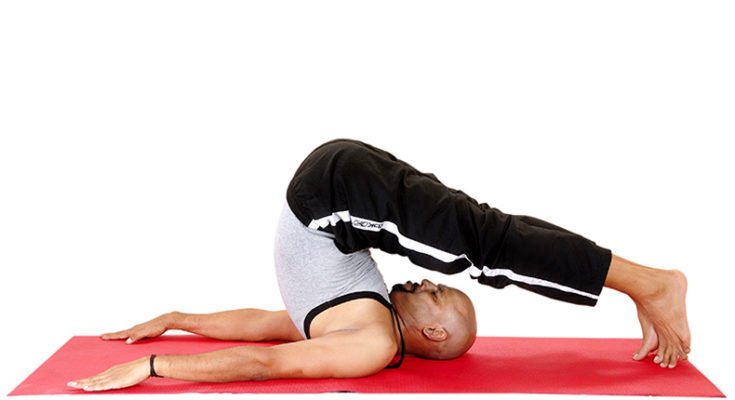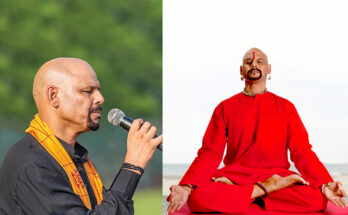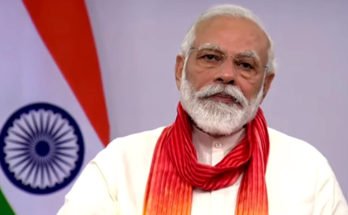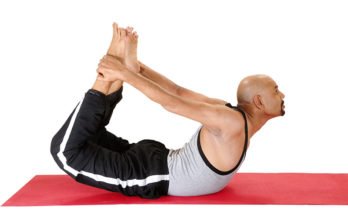Halasana – it gives flexibility to the spine and necks, nourishes the spinal nerves, and strengthens the back, shoulder, and arm muscles while releasing tension. Image Courtesy – Vijay Gautam
The deep breathing and gentle stretching of yoga help increase your blood circulation, improve your mood, boost your immune system, and increase your flexibility. Certain poses deepen feelings of relaxation and well-being while others treat specific types of chronic pain. The practice of yoga gives you time to slow down, relax, and reconnect, which helps you better manage chronic pain.
HALASANA:
The name comes from the Sanskrit words hala meaning “plow” and asana meaning “posture” or “seat”. See the topmost picture.
The practitioner lies on the floor, lifts the legs, and then places them behind the head.
Lying down on your back, with your legs together and your hands palms down by your sides, inhale and raise your legs up. Exhale, then inhale and bring your hips up off the floor.
Support your back with your hands, keeping your elbows as close to one another as possible. Then, without bending your knees, exhale and bring your legs down behind your head. If you cannot yet touch the floor with your feet, remain breathing deeply in this position.
If your feet comfortably reach the floor, walk them as far behind your head as you can and, with your toes curled under, push your torso up and your heels back. Stretch your arms out behind your back with the hands flat on the floor. Breathe slowly and deeply.
Benefits:
It gives flexibility to the spine and necks, nourishes the spinal nerves, and strengthens the back, shoulder, and arm muscles while releasing tension.
By compressing to the abdomen, it also massages the internal organs.
When you perform the Plough, be sure to keep your spine stretched up and your knees straight.
Your feet may not reach the floor to begin with, but as your spine becomes suppler, the weight of your legs will gradually pull them down.
Advanced students can go straight into the pose from the Shoulder stand, but beginners should relax in between. Use the Shoulder stand roll-out to come out of the Plough.
Caution: This pose can put significant strain on the cervical spine, which does not normally undergo this type of stress, and can cause injury if not performed properly.
As alternatives, simply lying on the back and raising the legs into a hamstring stretch, or doing a seated forward bend may be appropriate.
Read: Yoga for High Blood Pressure
MAYURASANA:
Sit down on the ground in Vajrasana. Bend forward raising your thighs and chest. Join your elbows together and take them at the centre of stomach. Now put complete body weight on your elbows and raise your legs and knees from the ground. Practice it for few days at the starting. After some days when you get good practice spread your legs behind like the feathers of a Peacock and keep the head straight. Make sure that your elbows are at the centre of the stomach. Keep your breathing normal. At the beginning practice it for 3 to 5 seconds and then increase the period gradually.
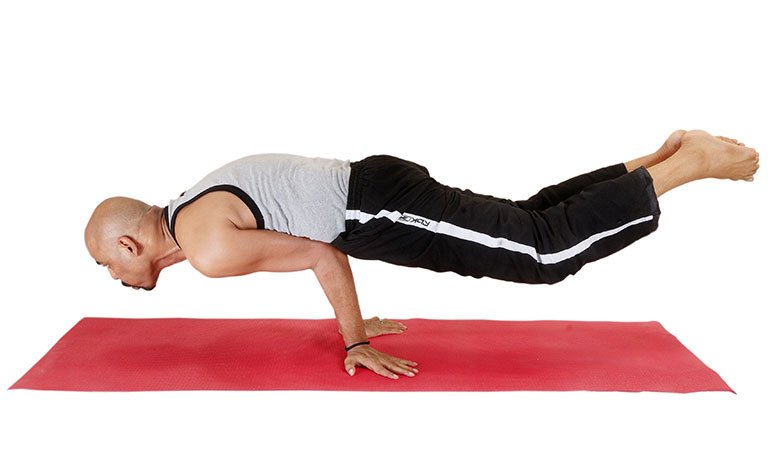
Mayurasana – this asana cures the stomach ailments and constipation. Image Courtesy – Vijay Gautam.
Benefits: This asana cures the stomach ailments and constipation. The heart, chest, spinal cord, arms, legs and ribs get strength and become stronger by practicing this. This asana brings glow on your face, and increases the vision of the eyes.
Caution: Weak and old people, and those suffering from High Blood Pressure and heart ailments should not practice this asana. As this is a very difficult Yogasana, it should be practiced under the supervision of a yoga teacher and do not do in a hurry. By practicing regularly, it becomes easy to do this asana.
KAPALBHATI PRANAYAMA:
‘Kapal’ means forehead and ‘Bhati’ means light or knowledge. Hence Kapalbhati Pranayama brings a state of light or clarity to the frontal region of the brain. Sit in any comfortable position. Keep head and spine straight and hands resting on the knees in ‘Jhyana Mudra’. Close the eyes and relax the whole body. Now without paying attention to inhaling, exhale with force rapidly and vigorously. Inhalation should be spontaneous involving no effort with each exhalation pull in the abdomen toward the spine. Perform 10 respirations to begin with. Continue the practice and slowly increase respiration.
Benefits: This Pranayama is useful for detoxifying the body. It improves the memory and sharpens the mind. Diseases like asthma, respiratory troubles, allergies and sinus etc get cured. This Pranayama purifies ‘Ida’ and ‘Pingla’ Nadis and also removes sensory distraction from the mind. It also relieves constipation, gas; blockages in arteries are also cleared. It also helps in losing weight. Peace and stability of mind is secured.
Caution: Those are who are having high blood pressure, heart problems and hernia should not do this Pranayama.
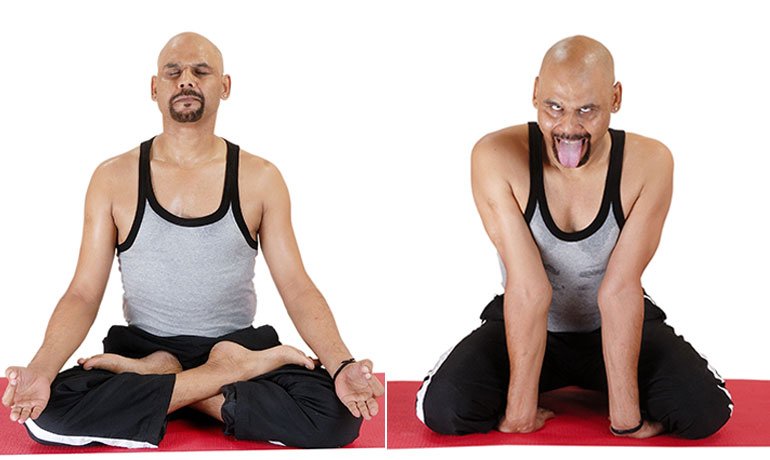
Kapalbhati Pranayama (left) and Singhagarjan Asana (right). Image Courtesy – Vijay Gautam.
SIGHAGARJAN ASANA (Roaring lion poses): Sit in ‘Vajrasana’. Knees apart parallel to your shoulders now place the palms of the Hands or the floor between the knees, with the fingers pointing towards the body. Lean forward and gently tilt the Head back and gaze at the eyebrow centre. Now inhale slowly and open the mouth and extend the tongue then while exhaling produce a sound from the “aach” keeping the mouth wide. Then close the mouth and breath in this is one round. Do it for minimum 10 rounds.
Benefits: Roaring lion pose is Ram ban for snoring and thyroid. This asana relieve stress and cerebral tension, alleviating anger, anxiety and insomnia. And this pose is excellent for alleviating diseases of throat, neck, nose, ears, eyes and mouth.
Read: Yoga for a good sleep
MATSYASANA (Fish Pose): This posture is dedicated to ‘Matsya’. ‘Matsya’ means a fish. Lie flat on you back keeping the legs straight on the floor with feet together. Bend the legs and put ‘Padmasana’ in the lying position. Carefully bend back ward, supporting the body with the arms and elbows. Lift the chest slightly, take the head back and lower the crown of the head to the floor. Hold the big toes and rest the elbows on the floor. Adjust the position of head and hands so that the back is arched to the maximum. Relax the arms and the whole body, allowing the head, buttocks and legs to support the weight of the body close the eyes and breathe slowly and deeply. Stay in this posture as long as you feel comfortable. Return to starting position, reversing the order of movements. Do it one time only.
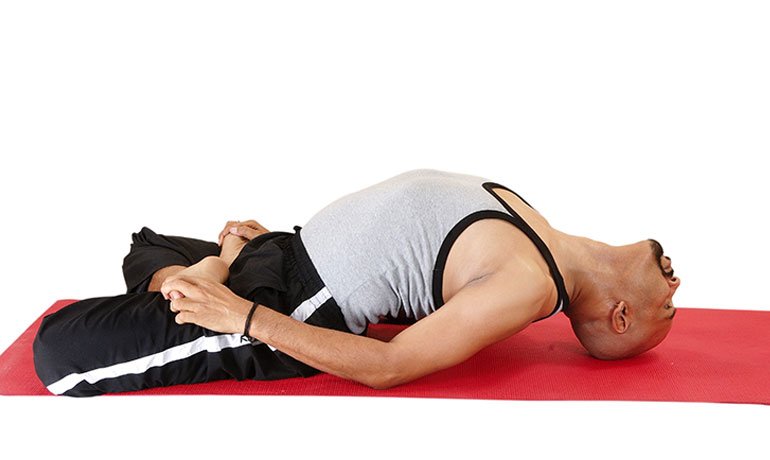
Matsyasana – this asana stretches the intestines and abdominal organs and is useful for all abdominal ailments. Image Courtesy – Vijay Gautam.
Benefits: This asana stretches the intestines and abdominal organs and is useful for all abdominal ailments. The dorsal region is fully extended in this posture and the chest is well expanded. Practice of this asana is very good for asthma and bronchitis as it encourages deep respiration. The asana is very useful for the treatment of Constipation, Tonsillitis, Spondylosis and disorders of reproduction system.
Caution: People who suffer for heart disease, hernia, ulcers, high blood pressure and pregnant women should not practice this asana.
SHAVASANA: Lie flat on the back with arms about 15 cm. away from the body. Palms should be facing up-wards. Let the fingers of both hands curl up slightly. Close the eyes. The head and spine should be on a straight line. Relax the whole body and stop all physical movements. Become aware of your natural breathing, now with every inhalation chant the word SO and with every exhalation think of the word HUM repeat the mantra for 5 to 10 minutes.
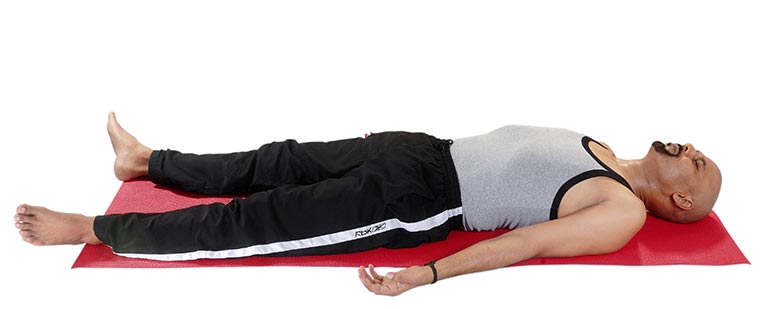
Shavasana – this asana relax the whole psycho-physiological system. Image Courtesy – Vijay Gautam.
Duration: According to the time available. Physically, first relax the whole body. Then focus on breath.
Benefits: This asana relax the whole psycho-physiological system. It should be practiced before sleep also tries not to move body at all during practice of this asana, because slightest movement will create muscular contraction. This asana works as Ram Barn for high blood pressure patients, heart patients, depression and stress.
Go Yogic Home Remedy for Chronic pain
Eating spinach once a day is an old-time remedy for relieving chronic body pain and fatigue. You can’t go wrong. Spinach contains potassium as well as many B vitamins, all of which are important to energy metabolism.

